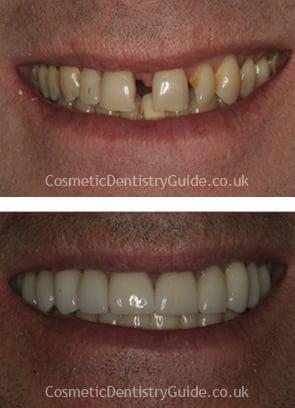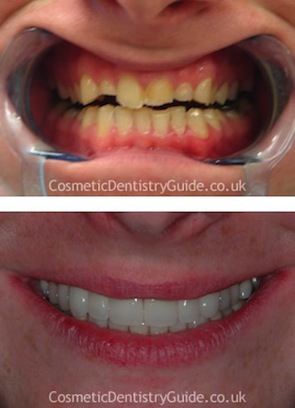

Reviewed by: Dr Mark Hughes
Dental veneers have long been used to create the ultimate smile makeover. With this treatment, it's possible to transform crooked, stained, damaged or badly worn teeth into a brand new, straight, white smile, as seen on many of the Hollywood greats.
Veneers are wafer-thin lamintates or shells of tooth-coloured material (which can be either porcelain, ceramic or composite bonding material). They are “cemented” to the front surface of teeth to improve their cosmetic appearance. Many dentists use the analogy that dental veneers are for your teeth what false fingernails are for your hands.
There are a wide variety of reasons why patients opt for treatment with dental veneers:
Stained teeth - badly stained teeth that cannot be improved by teeth whitening or prophyflex treatments can be greatly improved by dental veneers, which function to cover any existing stains on your teeth.
Damaged teeth - teeth that have become badly worn through excessive grinding or by carbonated drinks, as well as those that have been chipped or broken, can benefit from veneers. A small chip on a tooth can quickly be repaired with composite bonding, also knows as "composite veneers". A single damaged tooth can easily be repaired with a porcelain veneer that has the same characteristics and colour as you natural teeth.
Gaps - spaces or gaps (diastimas) between your teeth can easily be closed using dental veneers, giving you a more uniform-looking smile.
Crooked teeth - Veneers are not the ideal treatment for crooked teeth, and from the point of view of preserving your natural teeth structure, orthodontics or Invisalign braces would probably a better solution. However, such treatments can take up to a year or longer. For teeth that are not severely crooked, veneers placed over their front surface will give a straight and perfectly aligned-looking smile. For this type of treatment, many people refer to veneers as "instant orthodontics", as you get a similar end result in a fraction of the time.




The most popular type of veneers is porcelain, which offers a stronger and more durable alternative to its composite counterpart. Composite veneers are also more prone to staining and do not last as long as porcelain veneers. Porcelain veneers also offer a more natural looking, translucent appearance. Composite veneers are much cheaper than porcelain veneers in general, but considering that they do not last as long and need replacing more often, they could end up costing more in the long run. Composite work is ideal for small chips, as this treatment preserves more of your natural tooth structure.
1. The first part of any dental procedure is the initial consultation and examination, so that the dentist can get a feel for what you want and understand your needs and concerns. The dentist should explain the treatment procedure to you and give you an accurate guide to the likely costs of your treatment.
2. Before your veneers are designed, your dentist will need to reshape and prepare the front surfaces of your teeth so that they can accommodate the veneers. The first stage is to numb the teeth and gums with a local anaesthetic so that you do not feel anything during the procedure.
3. Using a special tool called a burr (a dental drill or file), a tiny part of the front surface of your teeth will be shaved off. The amount removed should be equivalent to the thickness of the veneer that will sit over the top of the tooth.
4. Next ,an impression or mould (copy) of your teeth is taken. A special dental "putty" is placed into your mouth on a tray and pushed into your teeth so that it takes an imprint of your teeth (similar to how you would leave a footprint in sand).
5. This "impression" or mould of your teeth is then sent to a dental laboratory. The laboratory uses the impression to cast an accurate model of your teeth, which is used as a guide to fabricate your new veneers. This process can take between one and three weeks.
6. While you're waiting for your veneers to be fabricated, your dentist may fit you with some temporary veneers to protect your prepared teeth. Not all dentists will offer temporary veneers.
7. On your second appointment, your dentist will fit your new veneers to your teeth. First, the dentist may just sit the veneers over your teeth to see how they look with your smile, as he/she may need to trim or adjust the veneer.
8. Next, your teeth will be thoroughly cleaned and the front surfaces etched (roughened) with a special acid gel so that they provide a good surface for the dental cement to stick to.
9. The veneers are then cemented into place, and a special curing light is used to activate the dental cement so that it permanently bonds the veneer to the front surface of your prepared tooth. If there is any excess cement, it is usually trimmed away and polished to leave a beautiful and natural-looking restoration.
Porcelain veneers will typically last between five and ten years, while composite veneers last a year or two at most. The bottom line is that your veneers will eventually need to be replaced. Although veneers are strongly cemented into place, there have been cases where they come loose and fall off. In such situations, it is important that you keep hold of your veneer and contact your dentist immediately. To make your veneers last longer, follow a good oral hygiene program and visit your dentist for check-ups on a regular basis.
Usually, porcelain veneers are placed over a minimum of two visits as described above. A few cosmetic dentists have invested in CAM/CAD in-house ceramic studios (CEREC), which can custom-produce high-quality ceramic veneers on-site in as little as six minutes. This CEREC technology enables the dental practice to offer single-visit, same-day ceramic veneers which are fitted within an hour. To read more about CEREC technology, click here.
Lumineers, are similar to standard porcelain veneers, but are fabricated made from a patented cerinate porcelain that is extremely thin (about the thickness of a contact lens) and very strong. With Lumineers, the tooth surface does not need to be trimmed, so the procedure is quicker and totally painless. A similar ultra-thin veneer system to hit the market is durathin veneers. To read more about Lumineers, click here to visit our main Lumineers page.
Da Vinci Veneers are similar to Lumineers in that they are extremely thin veneers that are often used for smile makeovers. They are only manufactured in the da Vinci laboratory in California. The da Vinci brand name is very popular, especially with high-profile cosmetic dentists in the States (who often have celebrities amongst their clients). Click here to visit our Da Vinci Veneers page
These are made from pressed ceramic, giving more strength than standard feldspathic veneers. They are an ideal veneer choice for smile makeovers. Read more about MAC Veneers here.
The latest removable fashion accessory is teeth grills or grillz. These are clip-on metal-based jewellery for your teeth. To read more about grills, click here.
Common missspellings for porcelain veneers include: pocelain, porclain, porcelin , porcelan, porcelane, porcelaen, porcelian, poreclain, procelain, porcelein, porceline, porselain, porselin, veners, veneeers, veeners, venears and vineers.